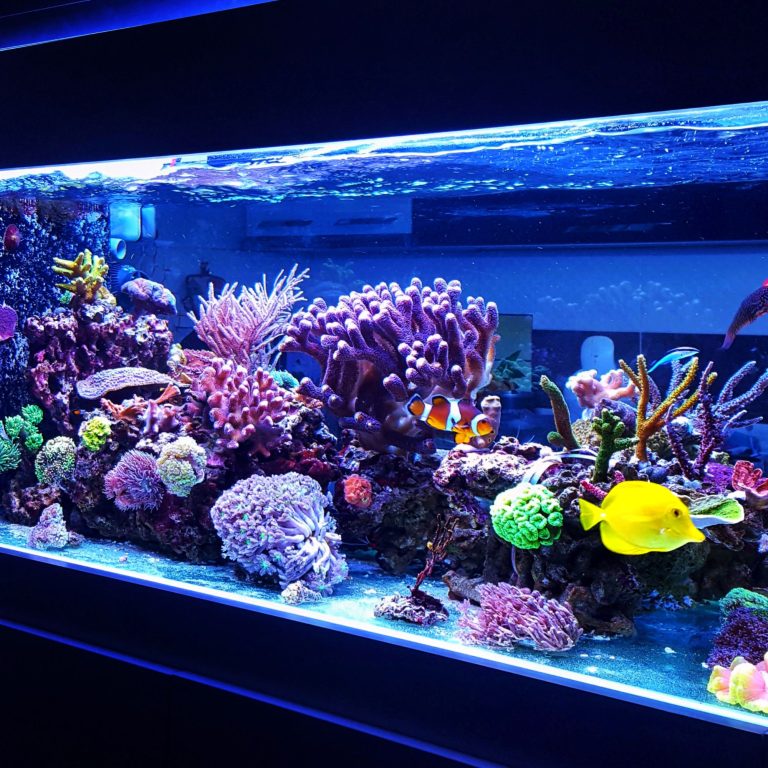Elevate Your Aquatic Game: Enhance Your Fish Tank with a pH Monitor
Enhancing Your Fish Tank Experience
Are you a passionate fish owner looking to take your aquatic game to the next level? Monitoring your fish tank is a crucial aspect of maintaining a healthy and thriving environment for your underwater companions. One essential tool that can greatly enhance your fish tank experience is a pH monitor.
The Importance of Monitoring Your Fish Tank
Maintaining the optimal conditions in your fish tank is vital for the health and well-being of your fish. Water parameters such as temperature, ammonia levels, and pH can significantly impact the overall environment. Monitoring these parameters allows you to detect any imbalances or fluctuations and take appropriate action to correct them. Regular monitoring helps prevent potential issues and ensures a stable and comfortable habitat for your fish to thrive in.
Introducing pH Monitors for Fish Tanks
Among the various monitoring systems available for fish tanks, pH monitors play a crucial role in ensuring the well-being of your aquatic friends. The pH level of the water indicates its acidity or alkalinity. Different fish species have specific pH requirements, and maintaining the appropriate pH level is essential for their health and longevity.
A pH monitor for your fish tank provides real-time monitoring of the water’s pH levels, allowing you to keep a close eye on any changes that may occur. By promptly detecting fluctuations, you can take the necessary steps to restore the pH balance and create an optimal environment for your fish.
In addition to pH monitors, there are other types of fish tank monitoring systems available, such as aquarium monitoring systems and smart fish tank devices. These devices utilize advanced technology to provide comprehensive data on various parameters, including pH, temperature, ammonia levels, and more.
By integrating a pH monitor into your fish tank setup, you can stay one step ahead in creating a healthy and thriving aquatic ecosystem. In the following sections, we will delve deeper into understanding pH levels in fish tanks and explore the benefits of using a pH monitor. So, get ready to elevate your fish tank experience to new heights!
Understanding pH Levels in Fish Tanks
To ensure the well-being of your aquatic friends, it is important to understand the pH levels in your fish tank. pH is a measure of the acidity or alkalinity of the water and plays a crucial role in creating a healthy environment for your fish. Let’s take a closer look at what pH is and why it matters, as well as the ideal pH levels for different fish species.
What is pH and Why Does it Matter?
pH is a scale used to measure the acidity or alkalinity of a solution, in this case, the water in your fish tank. The pH scale ranges from 0 to 14, with 7 being neutral. A pH value below 7 indicates acidity, while a value above 7 indicates alkalinity.
Why does pH matter in a fish tank? The pH level of the water directly affects the overall health and well-being of your fish. Fish, just like any other living organisms, have specific pH requirements for their optimal health and survival. Maintaining the proper pH level ensures that your fish can thrive and exhibit their natural behaviors.
Ideal pH Levels for Different Fish Species
Different fish species have varying pH requirements. It is essential to understand the ideal pH range for your specific fish to create an environment that mimics their natural habitat. Here is a general guideline for some commonly kept fish species:
| Fish Species | Ideal pH Range |
|---|---|
| Betta Fish | 6.0 – 7.5 |
| Goldfish | 7.0 – 7.5 |
| Neon Tetra | 6.0 – 7.0 |
| African Cichlids | 7.8 – 8.6 |
| Discus Fish | 5.5 – 6.5 |
| Guppies | 6.8 – 7.8 |
| Angelfish | 6.8 – 7.8 |
It’s important to note that these pH ranges are general recommendations and may vary slightly depending on the specific variety or sub-species of the fish. Consult reliable sources or seek advice from experienced aquarium enthusiasts for the most accurate and up-to-date information on pH requirements for your specific fish species.
By understanding the importance of pH and the ideal pH levels for different fish species, you can create a suitable environment that promotes the health and well-being of your aquatic pets. Monitoring the pH levels in your fish tank using a reliable fish tank pH monitor can help you ensure that the water conditions remain within the appropriate range. For information on other aspects of fish tank monitoring systems, check out our article on fish tank monitoring systems.
Benefits of Using a pH Monitor
When it comes to maintaining a healthy and thriving fish tank, using a pH monitor can make a world of difference. pH monitors offer a range of benefits that can greatly enhance your fish tank experience. Let’s explore two key advantages: real-time monitoring of pH levels and early detection of imbalances or fluctuations.
Real-Time Monitoring of pH Levels
A pH monitor provides you with the ability to keep a close eye on the pH levels in your fish tank in real time. This is particularly important because pH levels can change throughout the day due to factors such as fish waste, decaying plants, and the breakdown of food. By having a pH monitor in place, you can spot any sudden or gradual shifts in pH levels immediately, allowing you to take prompt action to address any issues that may arise.
By integrating a pH monitor into your fish tank setup, you can ensure that the pH levels remain within the ideal range for your specific fish species. Different fish species have varying pH requirements, and maintaining the appropriate pH level is crucial for the overall health and well-being of your aquatic pets. Consult our article on ideal pH levels for different fish species for more information.
Early Detection of Imbalances or Fluctuations
Fish tanks are delicate ecosystems, and even minor imbalances or fluctuations in pH levels can have a significant impact on the health of your fish. With a pH monitor, you can catch these imbalances early on, before they develop into more serious problems. This early detection allows you to take the necessary steps to restore the pH balance and maintain a stable environment for your fish.
By addressing imbalances or fluctuations promptly, you can help prevent stress-related illnesses and other health issues in your fish. Additionally, early detection of pH changes can also help you identify and rectify any underlying issues with your fish tank’s filtration system or other environmental factors that may be affecting the pH levels.
Investing in a pH monitor for your fish tank not only provides peace of mind but also contributes to the overall well-being of your aquatic pets. Remember, a stable and properly balanced pH level is crucial for the health, growth, and longevity of your fish. For more information on fish tank monitoring systems, check out our article on fish tank monitoring systems.
In the next section, we will discuss the features you should consider when selecting a pH monitor for your fish tank to ensure accurate and reliable monitoring. Stay tuned!
Features to Look for in a Fish Tank pH Monitor
When it comes to choosing a fish tank pH monitor, there are several important features to consider. These features can greatly enhance your experience in maintaining a healthy and balanced environment for your aquatic friends. Here are three key features to look for when selecting a fish tank pH monitor:
Accuracy and Precision
Accuracy is paramount when it comes to monitoring pH levels in your fish tank. Look for a pH monitor that provides precise readings and has a high level of accuracy. This will ensure that you can make informed decisions and take appropriate actions based on the pH data provided by the monitor.
A reliable fish tank pH monitor should also have a wide pH range, allowing you to monitor both acidic and alkaline conditions effectively. This is especially important if you house a variety of fish species with different pH preferences. To determine the accuracy and precision of a pH monitor, you can refer to product specifications and customer reviews.
Ease of Use and Installation
Choosing a fish tank pH monitor that is easy to use and install will make your monitoring experience hassle-free. Look for a monitor that comes with clear instructions and a user-friendly interface. It should be intuitive to operate and provide straightforward readings without any complicated processes.
Consider a pH monitor that offers simple calibration options. Calibration ensures that the readings provided by the monitor are accurate and reliable. Look for a monitor that makes calibration a quick and straightforward process so that you can spend more time enjoying your fish tank and less time on setup and maintenance.
Compatibility with Other Monitoring Systems
If you have other monitoring systems in place, such as temperature sensors or ammonia monitors, it’s beneficial to choose a fish tank pH monitor that is compatible with these systems. This compatibility allows you to integrate multiple monitoring components seamlessly and have a comprehensive understanding of your fish tank’s overall health.
By combining the data from different monitoring systems, you can gain valuable insights into the interplay between pH, temperature, and other water parameters. This helps you make more informed decisions and take appropriate actions to maintain optimal conditions for your fish. Check out our article on fish tank monitoring systems for more information on integrating different monitoring components.
By considering the accuracy, ease of use, and compatibility of a fish tank pH monitor, you can make an informed decision and select a monitor that aligns with your needs and preferences. Remember, maintaining proper pH levels is crucial for the health and well-being of your fish. With the right pH monitor in place, you can ensure a thriving aquatic environment and elevate your fish tank experience to new heights.
Taking Care of Your Fish Tank
Maintaining a healthy and thriving fish tank requires attention and care. In addition to using a pH monitor to keep track of the acidity or alkalinity levels in your tank, there are other essential factors to consider when it comes to taking care of your fish tank.
Maintaining Proper pH Levels
Proper pH levels are crucial for the well-being of your fish and other aquatic inhabitants. Different fish species thrive in specific pH ranges, so it’s essential to research and understand the ideal pH levels for your particular fish. Consult our article on ideal pH levels for different fish species for more information.
To maintain the proper pH levels in your fish tank, consider the following tips:
-
Regular Testing: Use your pH monitor to test the water regularly and keep track of any fluctuations. This will help you identify and address any imbalances promptly.
-
Water Changes: Regular partial water changes can help maintain stable pH levels. When performing water changes, make sure to use water that matches the pH of your tank to avoid sudden shifts.
-
Substrate and Decorations: Certain substrates and decorations can influence the pH of your tank. If you’re aiming for specific pH levels, choose aquarium materials that align with those requirements.
-
Chemical Adjustments: If necessary, you can use pH-adjusting chemicals to bring the pH levels within the desired range. However, be cautious and follow the instructions carefully, as excessive use of chemicals can be harmful to your fish.
By monitoring and maintaining proper pH levels, you create a comfortable and suitable environment for your fish to thrive.
Additional Tips for a Healthy Fish Tank Environment
In addition to pH monitoring, there are several other factors to consider for a healthy fish tank environment:
-
Temperature: Ensure that the water temperature remains within the appropriate range for your fish species. Use a reliable fish tank temperature monitor to keep track of the water temperature and make any necessary adjustments. Visit our article on fish tank temperature monitoring for more information.
-
Water Quality: Regularly test the water for parameters such as ammonia, nitrite, and nitrate levels. High levels of these compounds can be harmful to your fish. Utilize aquarium monitoring systems that include fish tank ammonia monitors and fish tank nitrate monitors to ensure optimal water quality. Check out our articles on fish tank ammonia monitors and fish tank nitrate monitors for more information.
-
Filtration: A quality filtration system is vital for maintaining a healthy fish tank. Ensure that your filter is properly sized for your tank and regularly clean or replace the filter media as needed.
-
Lighting: Provide appropriate lighting conditions for your fish and any live plants in your tank. Different species have different lighting requirements, so research your fish’s needs and adjust the lighting accordingly.
-
Feeding: Feed your fish a balanced diet and avoid overfeeding, as excess food can contribute to poor water quality. Remove any uneaten food to prevent it from decomposing and affecting the tank ecosystem.
By following these additional tips and using a pH monitor to keep your fish tank’s pH levels in check, you can create a healthy and thriving aquatic environment for your fish and other aquatic inhabitants. Remember to regularly monitor all the essential aspects of your tank, from pH to temperature and water quality, to ensure the well-being of your aquatic pets.







